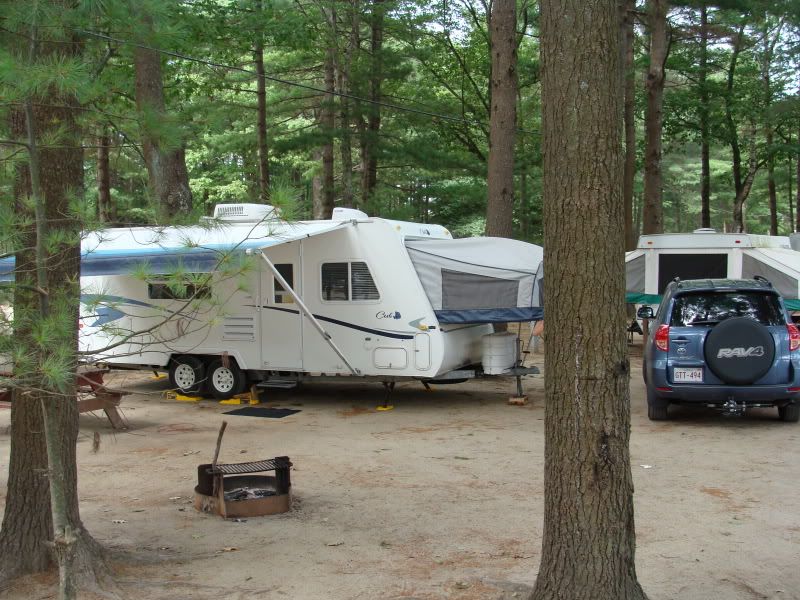Limoges_Camper
Sep 01, 2014Explorer
Another wat er damaged floor - 2006 Aerolite Cub BH23
We recently purchased a trailer that was supposed to be in near mint condition.
Once we brought it home, I noticed that the front steps were a bit springy on one side: sure enough, the floor was giving way.
These floors are made up of a cheap foam panel (not even using high density panels ... SMH...) sandwiched between 2 layers of of plywood. The top layer is 1/4" and the bottom l looks to be 1/8" with a layer of paper (yeah...) under it. There is some kind of a plastic methane under all of this.
Water got into the floor from what appears to be more than 1 spot: I'll deal with the causes.
I have removed almost all of the vinyl flooring: the front 60% of the trailer shows signs of water damage, staining, and was even wet in most areas (the stench when I lifted the vinyl!!!). Near the right (passenger side) wall, the top layer was completely rotten. I am removing some of that - resisting the urge to remove the complete layer.
The insulation is pretty well intact except for under the entrance where it cracked. Areas that had water-laden wood above it show staining inside the foam.
The bottom layer appears to be wet all over. I wonder of I should do anything about it.
My options as I see them:
Compete gut out where I replace everything from the bottom layer of plywood to the top layer, including upgrading the insulation to blue SM high density insulation and upgrading the top layer to 1/2". That would give me a stronger floor with better R-value.
An option I don't like is to just cover everything up and not bother with removing any of the damaged (mouldy) wood. I must get rid of the mould and make the trailer safe. I have seen where people have a spongy floor, and that is all they end up doing: isn't that bad for health reasons?
This is the plan that has the best compromise: remove the damaged portion of the top layer and replace with same material. Then add another layer of wood over the entire floor surface to add some strength. This would require me adding a support strip around the perimeter of the trailer (at key points only for weight control). I can add either another 1/4" or 1/2" layer. The problem becomes one of weight vs strength as each layer of 1/4" plywood weighs 25 lbs and 1/2" weighs 50 lbs.
So far I have removed the rotted wood on one side as well as a supporting 2 x 3 at the front step.
A note on the metal brackets supporting the front entrance: they need to be reinforced, and made longer so that they can properly hold the weight. I will post before and after pictures of this bracket. I highly recommend that owners with brackets like this perform this task sto get proper structural support.
So, any ideas/recommendations?
Once we brought it home, I noticed that the front steps were a bit springy on one side: sure enough, the floor was giving way.
These floors are made up of a cheap foam panel (not even using high density panels ... SMH...) sandwiched between 2 layers of of plywood. The top layer is 1/4" and the bottom l looks to be 1/8" with a layer of paper (yeah...) under it. There is some kind of a plastic methane under all of this.
Water got into the floor from what appears to be more than 1 spot: I'll deal with the causes.
I have removed almost all of the vinyl flooring: the front 60% of the trailer shows signs of water damage, staining, and was even wet in most areas (the stench when I lifted the vinyl!!!). Near the right (passenger side) wall, the top layer was completely rotten. I am removing some of that - resisting the urge to remove the complete layer.
The insulation is pretty well intact except for under the entrance where it cracked. Areas that had water-laden wood above it show staining inside the foam.
The bottom layer appears to be wet all over. I wonder of I should do anything about it.
My options as I see them:
Compete gut out where I replace everything from the bottom layer of plywood to the top layer, including upgrading the insulation to blue SM high density insulation and upgrading the top layer to 1/2". That would give me a stronger floor with better R-value.
An option I don't like is to just cover everything up and not bother with removing any of the damaged (mouldy) wood. I must get rid of the mould and make the trailer safe. I have seen where people have a spongy floor, and that is all they end up doing: isn't that bad for health reasons?
This is the plan that has the best compromise: remove the damaged portion of the top layer and replace with same material. Then add another layer of wood over the entire floor surface to add some strength. This would require me adding a support strip around the perimeter of the trailer (at key points only for weight control). I can add either another 1/4" or 1/2" layer. The problem becomes one of weight vs strength as each layer of 1/4" plywood weighs 25 lbs and 1/2" weighs 50 lbs.
So far I have removed the rotted wood on one side as well as a supporting 2 x 3 at the front step.
A note on the metal brackets supporting the front entrance: they need to be reinforced, and made longer so that they can properly hold the weight. I will post before and after pictures of this bracket. I highly recommend that owners with brackets like this perform this task sto get proper structural support.
So, any ideas/recommendations?














